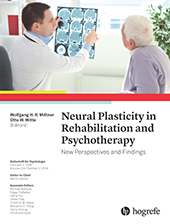Neural Plasticity in Rehabilitation and Psychotherapy
New Perspectives and Findings
References
(2016). Maladaptive plasticity induces degradation of fine motor skills in musicians: Apollo’s curse. Zeitschrigt für Psychologie, 224, 80–90. doi: 10.1027/2151-2604/a000242
(2016). Plasticity during short-term visual deprivation. Zeitscrift für Psychologie, 224, 125–132. doi: 10.1027/2151-2604/a000246
(2011). Current trends in stroke rehabilitation: A review with focus on brain plasticity. Acta Neurologica Scandinavica, 123, 147–159.
(1979). Psychotherapy and the single synapse: The impact of psychiatric thought on neurobiological research. New England Journal of Medicine, 301, 1028–1037.
(2008). Psychiatrie, Psychoanalyse und die neue Biologie des Geistes
[Psychiatry psychoanalysis, and the new biology of the mind] . Frankfurt/M, Germany: Suhrkamp Verlag.(2016). Adaptive and maladaptive neural plasticity due to facial nerve palsy: What can we learn from pure deefferentation? Zeitschrift für Psychologie, 224, 102–111. doi: 10.1027/2151-2604/a000244
(2013). Soft-wired: How the new science of brain plasticity can change your life. San Francisco, CA: Parnassus Publishing.
(2014). Brain plasticity-based therapeutics. Frontiers in Human Neuroscience, 8, 385. doi: 10.3389/fnhum.2014.00385
(2016). Plasticity and reorganization in the rehabilitation of stroke: The constraint-induced movement therapy (CIMT) example. Zeitschrift für Psychologie, 224, 91–101. doi: 10.1027/2151-2604/a000243
(2016). Change in movement-related cortical potentials following constraint-induced movement therapy (CIMT) after stroke. Zeitschrift für Psychologie, 224, 112–124. doi: 10.1027/2151-2604/a000245
(2016). Effects of psychotherapy on brain activation patterns in anxiety disorders. Zeitscrift für Psychologie, 224, 62–70. doi: 10.1027/2151-2604/a000240
(2016). Plasticity and cortical reorganization associated with pain. Zeitschrift für Psychologie, 224, 71–79.
(2008). The concept of brain plasticity: Paillard’s systemic analysis and emphasis on structure and function (followed by the translation of a seminal paper by Paillard on plasticity). Behavioural Brain Research, 192, 2–7. doi: 10.1016/j.bbr.2007.11.008
(2016). Impairment of brain plasticity by brain inflammation. Zeitschrift für Psychologie, 224, 133–138. doi: 10.1027/2151-2604/a000247



